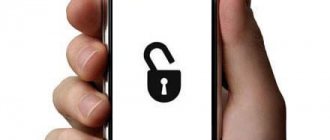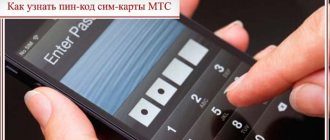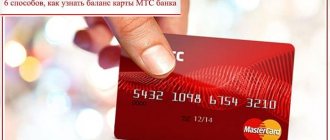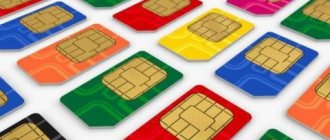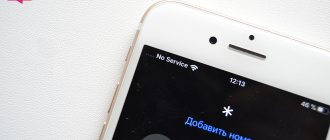How to find out the serial number of a SIM card?
Information about who, where and when produced a given product is encrypted in the serial number of almost every technological device. The SIM card belongs to the same series and has its own serial number indicated next to the chip.
Knowing the serial number of a SIM card can solve some problems in case of theft or loss of a gadget, as well as when restoring access if you have forgotten the PUK code. You can check the serial number of your SIM card in a special application:
- ICCID for Android. On Google Play, download and install the application, then in the program settings find the “About phone” item (at the bottom of the page) – the “General information” sub-item – “Sim cards”;
- For iPhone you can use SIM Serial Number. In the settings, go to “General”, then the sub-item “About the device”. All the necessary information will be on the smartphone screen.
Another application for determining information about a SIM card is SIM Card Details.
You can find out the ICCID of SIM cards using a computer. To do this, you need to connect the gadget to your PC and launch iTunes. Find the mobile phone and open “Overview”, in the window that appears, left-click on the phone number several times until the required information appears. Copy and save the serial number of the SIM card.
What are the sizes of SIM cards?
As we have already said, the size of SIM cards has been regularly reduced. In the table below we show the sizes of all four types of SIM cards that currently exist.
| SIM card format | Application | Length (mm) | Width (mm) | Thickness (mm) |
| Full size (1FF) | Outdated, not used. | 85,60 | 53,98 | 0,76 |
| Mini-SIM (2FF) | Almost never used, can be found in old mobile phones. | 25,00 | 15,00 | 0,76 |
| Micro-SIM (3FF) | Used in push-button mobile phones and budget smartphones. | 15,00 | 12,00 | 0,76 |
| Nano-SIM (4FF) | The most modern SIM card format. Used in mid- and high-price smartphones. | 12,30 | 8,80 | 0,67 |
When purchasing a new mobile phone or smartphone, it often turns out that the existing SIM card is not the right size. If you need a larger SIM card, you can use a special adapter that allows you to insert a SIM card into a larger slot. Now such adapters come with any new card, but they can also be purchased separately.
Most often you need a smaller card, for example, you have a card in Micro-SIM format, but you need a Nano-SIM. There are several ways to solve this problem. For example, you can simply contact the mobile operator’s office and ask to replace the card with a new one. This procedure usually takes only a few minutes and is absolutely free. You can also make the SIM card smaller by simply cutting it to the desired size. This procedure is best done using a special device (Sim Cutter or SIM card stapler).
However, you can take a risk and try to reduce the size of the SIM card manually, using scissors. The picture above shows what dimensions you need to follow in order to cut Micro-SIM from Mini-SIM (on the left) and Nano-SIM from Micro-SIM (on the right).
SIM card (English: subscriber identification module) is a subscriber identification module used in mobile communications.
With the development of technology in the mobile industry and the growing requirements for cell phones, there is a need to create new formats of SIM cards for phones.
This is due to the fact that the hardware of today's phone is becoming more and more complex, and the size of modern smartphones is becoming smaller. Thus, manufacturers have to save as much space as possible when developing new phone models.
The picture clearly shows the differences between different types of SIM cards. the largest is a full-size sim
(86.60x53.98x0.76).
Few people saw the “big SIM card”; such SIM cards appeared in 1991 and were used at the beginning of the development of cell phones. Most people are accustomed to the next largest SIM card, mini-sim
(25x15x0.76), this card appeared in 1996 and is installed in almost all GSM phones.
further in size is micro-sim
(15x12x0.76), 2003, this standard was introduced and is used in smartphones 4, 4s, as well as all first generations of ipad.
the smallest card is nano-sim
(12.30x8.80x0.67), this standard was also introduced in October 2012 and is used in phones starting with smartphone 5 and ipad mini tablets.
Options for the next generation of SIM cards (5ff) are being developed, which probably will not be replaceable.
How to cut a SIM card for micro sim?
Having bought a new phone or tablet (for example, htc, smartphone or ipad), you may find that a standard SIM card does not fit it and in order to continue using your usual SIM card after purchasing a new device, you need to cut it off. The main chip remains in place, only the size of the plastic base is reduced. It’s not difficult to make a micro sim from a regular SIM card at home; you only need sharp nail scissors, a sharpened pencil, a ruler, sandpaper (or a nail file) and a little patience.
As mentioned above, a regular SIM card is a plastic rectangle with a chip with parameters of 25x15 mm. The dimensions of the micro SIM card must be 15x12 mm. You can cut a regular SIM card to the desired size as follows:
This method is also suitable if you need to cut microsim to nanosim.
If the SIM card after resizing is larger than necessary, this can always be corrected; if the size is significantly smaller, the SIM card will become impossible to use and you will have to change it to a new one.
The opposite situation is also possible - using a micro SIM card in devices with standard slots. To do this, you will need a special adapter for micro SIM cards, which can be purchased at any communication store. this way, your micro SIM card will become universal for most devices.
Do you want to use several SIM cards in your phone at once? Then buy yourself with cash on delivery.
SIM stands for "identification module") contains a lot of important data that is necessary to connect to the signal. At the same time, it limits the phone to a specific carrier or region.
The main task of a SIM card is to save account information, which allows the user to easily and simply change without changing their account. You just need to move the SIM card to . To perform this task, the SIM card is equipped with a microprocessor with software and data with card identification keys.
In addition, SIM cards can store additional information - a list of user contacts, a list of phone calls, the text of SMS messages. Although in modern phones such data is recorded in the memory of the phone itself, and not on the SIM card.
ICCID (ICC) what is it?
All information about the SIM card, including the serial number, is encrypted in ICCID (Integrated Circuit Card IDentifier). This is an international unique identifier containing information about the country, mobile operator, SIM card itself and subscriber number.
What data does it contain?
A knowledgeable person, looking at the 19 ICCID characters (old cards may have a 20-digit code), can determine the country of origin, the organization that issued the card, and the personal SIM card number. It is distributed like this:
- The first two digits are the code for the telecommunications services sector. It's always 89;
- The next group of numbers from one to three indicates the country. For example, for Russia it is 7, for Ukraine – 380;
- Then a group of two to four digits containing the code of the operator who issued the card;
- The block of 11 digits is the SIM card's immediate ID (IID), which does not have a common standard, but is used to link a specific SIM card to the operator's software;
- The last digit or letter is used as an additional check number.
Should we be afraid of total surveillance?
Indeed, if this type of number is easy to track, then is it worth fearing? For example, the actions of foreign intelligence services? Or the national police?
Law enforcement officers themselves do not have the ability to carry out such tracking. Only representatives of mobile operators have such opportunities. And they can provide them only after a reasonable request. That is, CIA or FBI agents will still have to first contact our police, who will then submit a request to the operator, and only after that the required information will be provided.
That is, if the card belongs to MTS, you will have to contact this company. If the SIM was issued by Beeline, then to this organization. No other way.
IMSI what is it?
In addition to the 19-digit ICCID code (ICC), the Sim card has another code stored in the card’s memory. This code is called IMSI (International Mobile Station Identity) and consists of 15 digits.
What data does it contain?
Information encrypted in IMSI includes data:
- About the country where this SIM card was purchased. The code contains 3 digits and is called Mobile Country Code (MCC);
- About the cellular operator within the country. These are the next two digits, the Mobile Network Code (MNC);
- 10 digits subscriber number.
Why is this code needed?
The IMSI code is used by the operator to link the subscriber number to the SIM card. With its help, the subscriber gains access to cellular communication services.
If the SIM card is lost, the telecom operator at the point of sale uses a new card without reference and enters the required subscriber number in the IMSI code. After this, the user receives a SIM card with a new ICCID code, but with the old number.
Using the IMSI code, you can determine the country and telecom operator of the SIM card owner.
Why is such an identifier required?
It allows you to obtain the following information:
- Find out the location of a person, or rather not of him, but of a phone that is turned on and contains a SIM card;
- The mobile number itself, as well as some information about its owner.
It’s quite easy to find out a person’s details. To do this, our country now does not even require any additional digital technologies. After all, now, according to the law, buying a mobile phone card requires presenting a passport and filling out a special form. Naturally, it is saved and can be accessed under certain conditions.
The location of the activated phone with the card is also determined using special technologies that mobile operators have at their disposal.
That is, most often ICCD is used for the following purposes:
- To try to find a person, for example, if he is wanted;
- To find a stolen phone;
- To find out some information needed by the same law enforcement agencies.
What do the numbers on the SIM card mean?
The SIM card and plastic base contain several blocks of numbers. They encrypt various information. The SIM card itself containing the chip has an ICCID code (ICC) containing 19 digits.
The plastic base contains PIN and PUK codes, as well as a barcode that is applied to all manufactured products.
Additionally, telecom operator numbers used to obtain information about the status of the account, manage services, and rescue services may be indicated. If the user purchases a new SIM card, then the subscriber number is also indicated.
Reviews from people
Is knowing such an identifier useful or not? This can be seen from the reviews:
- Alina. Once I forgot my cell phone at the bar. I thought that was it. I won't see him again. My brother suggested that I go to the service and track the phone’s activation. I saw that it was turned on. I called my number. Agreed to meet. They returned it for a little gratitude.
- Matvey. I gave my wife the latest version of an iPhone. And she lost it a week later on a minibus. I contacted the police and wrote a statement. A week later they returned it, it turned out that it had been stolen and they were trying to activate it. And the police tracked them at that moment.
- Olga. This code didn't help me at all. I contacted the police station and asked to find him. They submitted a request to the operator. They replied that no one had activated the card. In general, it didn't help me.
- Novel. I accidentally blocked my card. And I really need her. Fortunately, I have friends in the police. I contacted them and they gave me a PUK, which allowed me to restore access.
That is, this code can be very useful in cases where a mobile device is stolen, and the attacker forgot to remove the card from it. Or in situations where a person, for some reason, cannot use the phone, and finding out its location is very important. For example, he had an accident and cannot move, but his mobile phone is on.
“>

